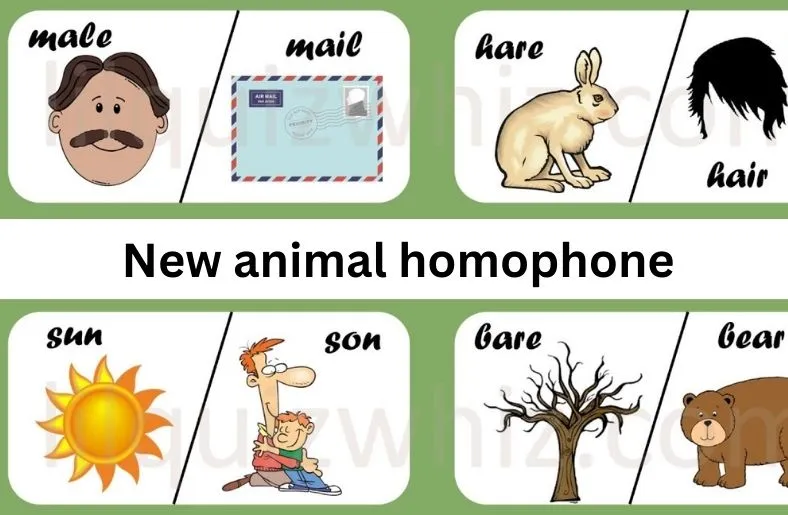“New animal homophones” are a fascinating aspect of language, woven with words that sound alike yet carry distinct meanings. Among these delightful nuances, homophones stand out, capturing our attention and sparking curiosity. In particular, animal-related homophones add an extra layer of charm and whimsy. They not only enhance our vocabulary but also provide opportunities for creativity and humor.
In this exploration, we will delve into the intriguing realm of “new animal homophones.” By focusing on these unique pairs, we can appreciate how language evolves and reflects our experiences with the animal kingdom. So, get ready to embark on a linguistic adventure that uncovers the playful side of words and celebrates the joy of discovery!
Understanding Homophone
Homophones are intriguing words that sound alike but have different meanings and spellings. For example, “pair” and “pear” illustrate how pronunciation can lead to varied interpretations. This linguistic phenomenon occurs because, despite identical sounds, the words convey entirely different concepts. In communication, homophones can be both amusing and confusing.
Understanding homophones is crucial for effective language use. They play a significant role in enriching our vocabulary and enhancing our expressive capabilities. For instance, the words “flour” and “flower” can change the meaning of a sentence entirely. This highlights the importance of context when using homophones.
Furthermore, homophones encourage creative wordplay in literature and conversation. Writers often use them to create puns and jokes, adding humor to their work. As we explore “new animal homophones,” we uncover the delightful ways language can surprise us. This understanding not only sharpens our language skills but also fosters a deeper appreciation for the nuances of communication.
Exploring Common Animal Homophones
- Bear/Bare: The word “bear” refers to a large, furry mammal, while “bare” means uncovered. Picture a bear wandering through the woods, proudly showing off its bare paws!
- Deer/Dear: “Deer” signifies the graceful animal that roams meadows, whereas “dear” is an affectionate term. Imagine a letter addressed to a “dear deer,” inviting it to tea!
- Flea/Flee: The tiny insect “flea” often troubles pets, while “flee” means to run away quickly. Picture a cat trying to flee from an annoying flea!
- Hare/Hair: “Hare” is a fast-moving creature, while “hair” refers to strands growing from our skin. Visualize a hare with a fabulous hairdo, racing past in a race against time!
- Seal/Seal: A “seal” can either be the marine animal or the act of closing something securely. Imagine a seal balancing a ball while sealing a letter!
- Enriching Language: These animal homophones enrich our language by adding layers of meaning and humor. They spark creativity and laughter in conversations.
- Anecdotes and Humor: These homophones often lead to amusing misunderstandings. Saying something like, I saw a bear that was bare! can conjure humorous imagery.
The Emergence of New Animal Homophone
The emergence of new animal homophones reflects recent trends in language evolution. As society changes, so do the words we use, often influenced by technology and social media. For instance, terms like “gnu” (a type of antelope) and “new” (recently made) are increasingly recognized as homophones. Similarly, “ewe” (a female sheep) and “you” (the person being addressed) showcase how playful language can be.
In today’s digital age, platforms like Twitter and Instagram foster the creation of these homophones, allowing for rapid spread and acceptance. Memes and hashtags often highlight these word pairings, making them part of everyday conversation. Furthermore, as people engage with language creatively, new animal homophones emerge, enriching our vocabulary. This evolution not only enhances our communication but also encourages linguistic exploration and fun, reflecting the dynamic nature of language in a modern context.
Creative Uses of Animal Homophone in Communication
Creativity in language plays a vital role in enhancing communication. Animal homophones provide a unique opportunity for writers and poets to engage their audiences through clever wordplay. For example, in literature, Shakespeare masterfully used homophones to create humor and depth. One famous instance is when characters play with words like “flour” and “flower,” blending meanings seamlessly.
Moreover, in pop culture, cartoons and jokes often highlight animal homophones for comedic effect. A well-known gag features a “bear” and a “bare” situation, showcasing the humor in language. These examples illustrate how creativity fuels our understanding and appreciation of language. By incorporating animal homophones, writers add layers of meaning, making their work more engaging. Thus, exploring these playful word connections not only entertains but also enriches our communication skills. Ultimately, the creative use of animal homophones reflects the beauty of language and its capacity for imagination.
Tips for Incorporating New Animal Homophone
- Practical Advice for Using Animal Homophones: Incorporating animal homophones into your writing and speech adds creativity. Start by identifying pairs like “hare/hair” to enhance descriptions.
- Use in Everyday Conversations: Challenge yourself to weave these homophones into daily discussions. This not only improves your language skills but also makes conversations lively.
- Engaging Games and Activities: Try word games like “homophone bingo” or “word matching” to practice. These activities make learning fun and interactive for all ages.
- Creative Writing Prompts: Encourage yourself to write short stories featuring animal homophones. For instance, imagine a tale where a “dear” friend helps a “deer” in need.
- Involve Others: Share your findings with friends or family, and encourage them to create their own examples. This collaborative effort makes exploring language enjoyable.
- Regular Practice: Consistent practice helps solidify your understanding of homophones. Consider dedicating a few minutes each week to discover new pairs.
Conclusion of New Animal Homophone
Exploring new animal homophones is an exciting journey that enriches our understanding of language. By embracing linguistic creativity, we open doors to playful word associations that enhance communication. Animal homophones not only make conversations more engaging but also spark our imagination. Therefore, I encourage you to dive into this delightful world of words. As you discover and create your own animal homophones, don’t hesitate to share your favorites with others. Your unique contributions can inspire friends and family to join in on the fun. Let’s celebrate the magic of language together!





